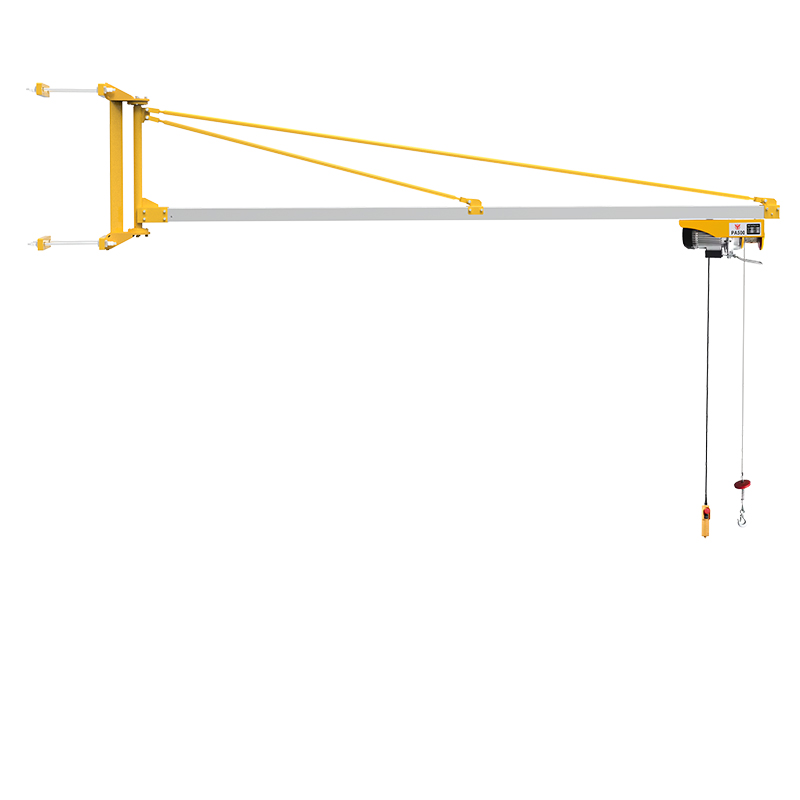Introduction to Jib Cranes
Table of Contents
ToggleAs industries seek ways to optimize floor space without compromising lifting capacity, wall-mounted jib cranes have emerged as an ideal solution for space-constrained environments. Known for their versatility, cost-effectiveness, and efficient design, wall-mounted jib crane also called wall jib crane or wall swing crane is widely used in workshops, warehouses, assembly lines, and fabrication shops.
In this article, backed by real-world experience, technical expertise, authoritativeness, and a foundation of trustworthiness, we provide a complete overview of wall-mounted jib crane, including installation guidance, benefits, and ideal use cases. We also contrast wall-mounted systems with other types of jib crane to help you determine the best fit for your operational needs.
What Is a Wall-Mounted Jib Crane?
A wall-mounted jib crane is a type of jib crane that attaches directly to a building’s structural wall or a supporting column. Unlike freestanding jib cranes, it does not require a foundation or floor support, making it an excellent choice for facilities that need to conserve floor space.
Common Terms:
- Wall Jib Crane: A general reference to the type.
- Wall Swing Crane: Highlights the crane’s horizontal pivoting motion.
- Cantilever Jib Crane: A subtype that extends horizontally without additional support bracing underneath.
To learn the fundamentals of jib cranes, including their components and general operation, visit: what’s jib crane.
Key Features of Wall-Mounted Jib Crane
Wall-mounted jib cranes come with distinct characteristics that make them suitable for a wide range of lifting tasks:
1. Space Efficiency
- The crane arm is attached to the wall, leaving the floor entirely free for other equipment or storage.
- Ideal for tight or crowded areas, especially production lines or near workstations.
2. 180° to 200° Rotation
- Offers sufficient movement within the crane’s operating envelope.
- Great for moving loads from conveyors to benches or machines.
3. Load Capacity and Reach
- Typically supports loads ranging from 250 kg to 2,000 kg.
- Horizontal reach depends on wall structure, often between 2–6 meters.
4. Custom Configurations
- Adjustable boom length, trolley options, and hoist types are available to fit specific tasks.
Benefits of Wall-Mounted Jib Crane
Wall-mounted jib cranes are useful across various industrial sectors. Here are the top benefits:
1. Floor Space Optimization
Since they’re mounted above ground level, wall jib cranes don’t obstruct pathways or machinery placement.
2. Reduced Installation Costs
No need for concrete foundations or base plates, reducing installation expenses and time.
3. Ease of Use
Simple controls and manual or motorized hoists make them suitable for both light-duty and medium-duty lifting.
4. Improved Worker Safety
By reducing manual lifting and improving ergonomics, wall-mounted cranes reduce the risk of injury.
5. Cost Efficiency
Compared to freestanding cranes, wall-mounted systems require fewer materials and support structures, lowering initial costs.
Ideal Applications of Wall-Mounted Jib Crane
- Manufacturing Lines: Assist in positioning heavy parts on CNC machines or assembly benches.
- Auto Workshops: Lift engine blocks or components near inspection stations.
- Warehouse Docking: Transfer boxes or packages between pallets and conveyor belts.
- Maintenance Areas: Support equipment replacement and component handling in tight spaces.
Wall-mounted jib cranes are often paired with workstation tools or roller conveyors to boost productivity in a localized area.
Jib Crane Installation: What You Need to Know
Proper jib crane installation is essential to ensure safety and structural integrity.
Installation Steps:
- Structural Assessment: Verify that the wall or column can support the crane’s load and dynamic forces.
- Anchor Points: Use certified anchor bolts and brackets rated for the specific load.
- Mounting: Position the bracket and boom precisely. Torque all fasteners to manufacturer specifications.
- Testing: Conduct load tests per ISO or OSHA standards to ensure safe operation.
Expert Tip:
Engage structural engineers or manufacturers to review wall load-bearing capacity, especially in older buildings.
Comparing Wall-Mounted Jib Cranes to Other Types
While wall-mounted jib cranes are advantageous in many ways, it’s important to evaluate them alongside other configurations:
| Type of Jib Crane | Rotation | Floor Space Needed | Installation Cost | Load Capacity |
|---|---|---|---|---|
| Wall-Mounted | 180–200° | Minimal | Low | Light–Medium |
| Freestanding | 360° | High | High | Medium–Heavy |
| Articulating | 200–360° | Variable | Moderate | Light |
For a complete comparison, see our guide on types of jib crane.
Maintenance and Safety for Wall Jib Cranes
Maintaining your wall swing crane ensures long-term reliability and compliance with safety standards.
Maintenance Checklist:
- Monthly Inspection: Check bolts, welds, and brackets for stress or fatigue.
- Lubrication: Apply grease to the pivot joint and trolley bearings.
- Hoist Inspection: Monitor cable condition and brake function regularly.
- Cleaning: Wipe down to prevent dust and grime buildup on the hoist motor and tracks.
Safety Tips:
- Ensure load does not exceed rated capacity.
- Train operators in safe use and emergency procedures.
- Keep rotation path free from obstructions.
Is a Wall-Mounted Jib Crane Right for You?
Choose a wall-mounted jib crane if:
- Your facility has strong structural walls or support columns.
- You need lifting assistance within a localized area.
- Floor space is limited and must remain unobstructed.
- Load capacities range from light to moderate.
If these conditions match your use case, wall jib cranes are a cost-effective, safe, and practical solution.
Conclusion: Space-Efficient Powerlifting with Wall-Mounted Jib Cranes
Wall-mounted jib cranes deliver practical, safe, and space-saving lifting capabilities for industrial applications of all sizes. With their ability to streamline workflows, reduce manual handling, and enhance overall workplace safety, these cranes have become an indispensable tool in modern manufacturing and logistics operations.
Ready to upgrade your lifting system? Explore our wide range of models for more jib crane products designed for diverse applications.
To understand how wall-mounted cranes fit within the broader category of material handling equipment, revisit our essential guide: what’s jib crane.

















Please log in to leave a comment.